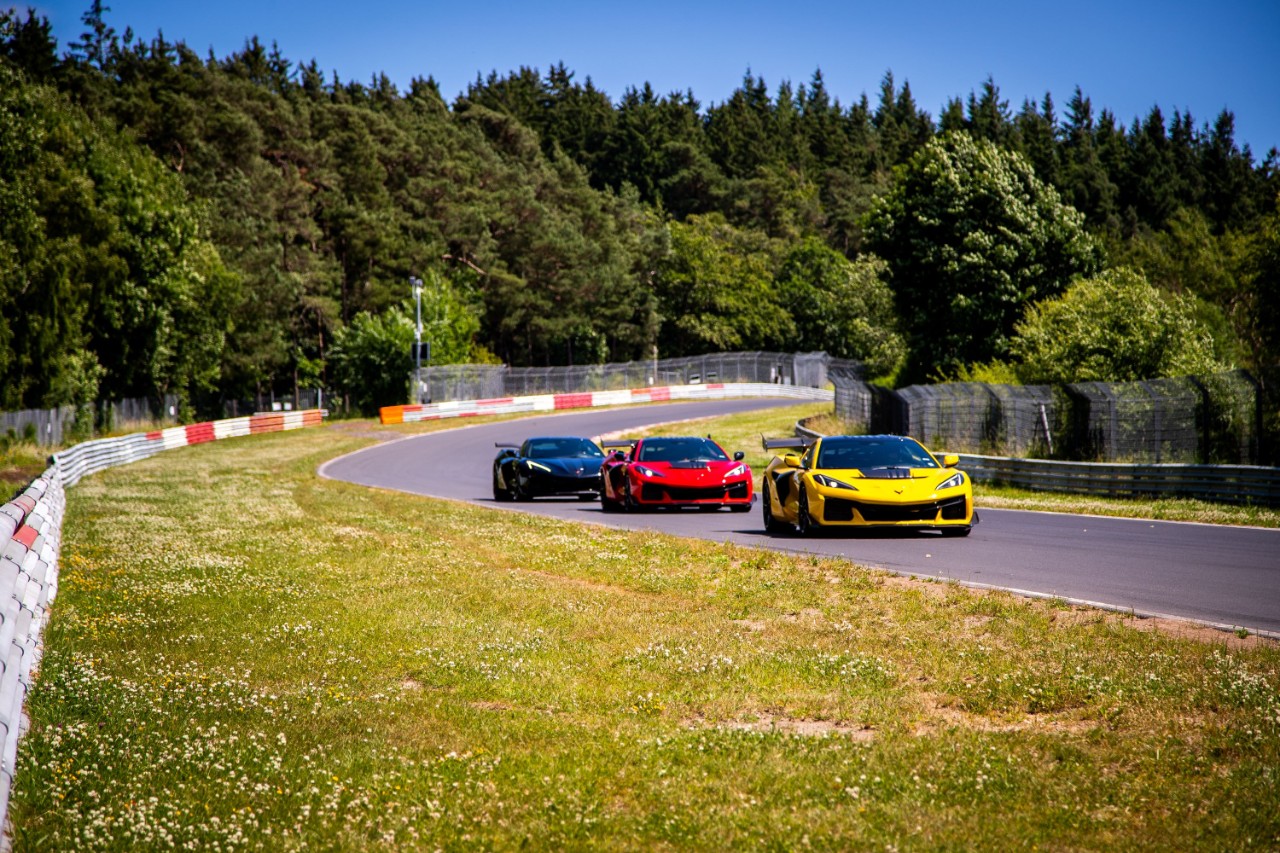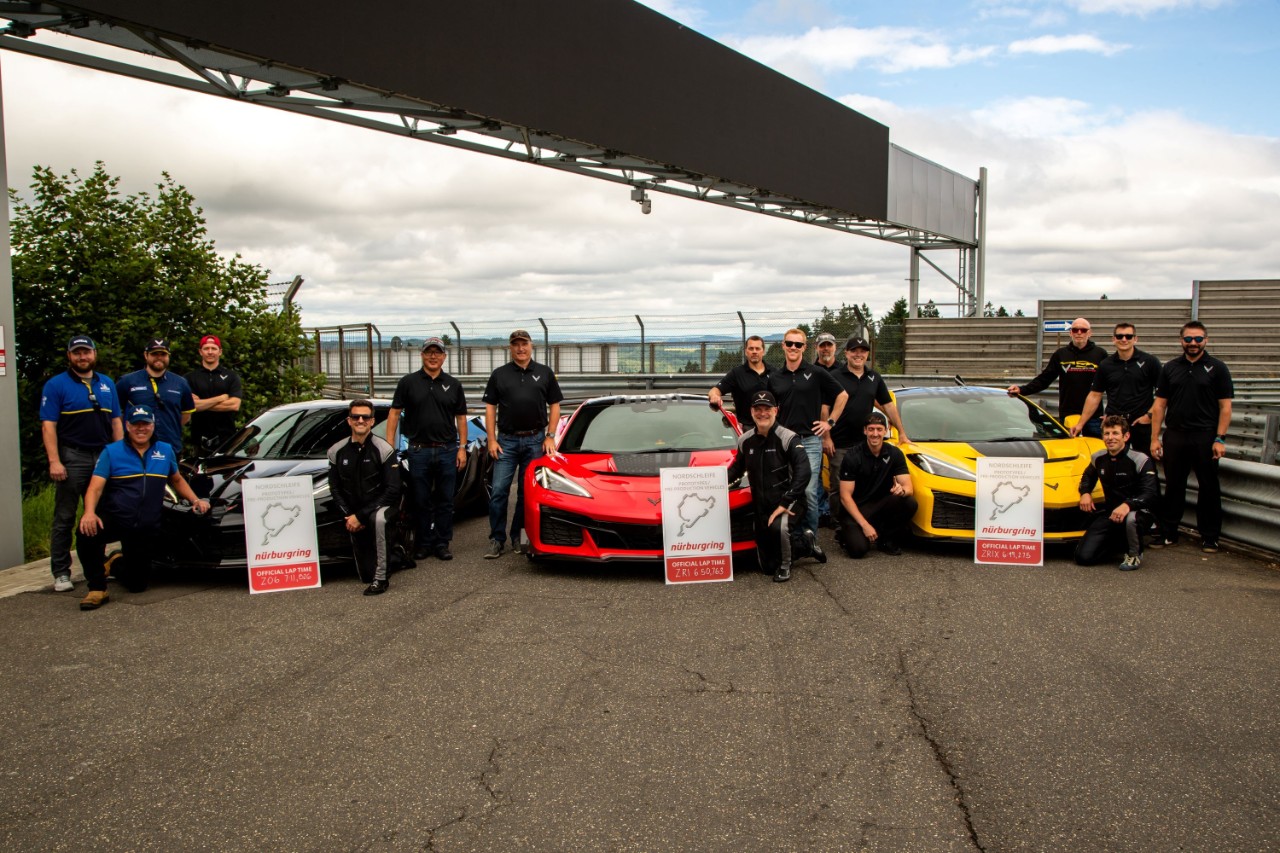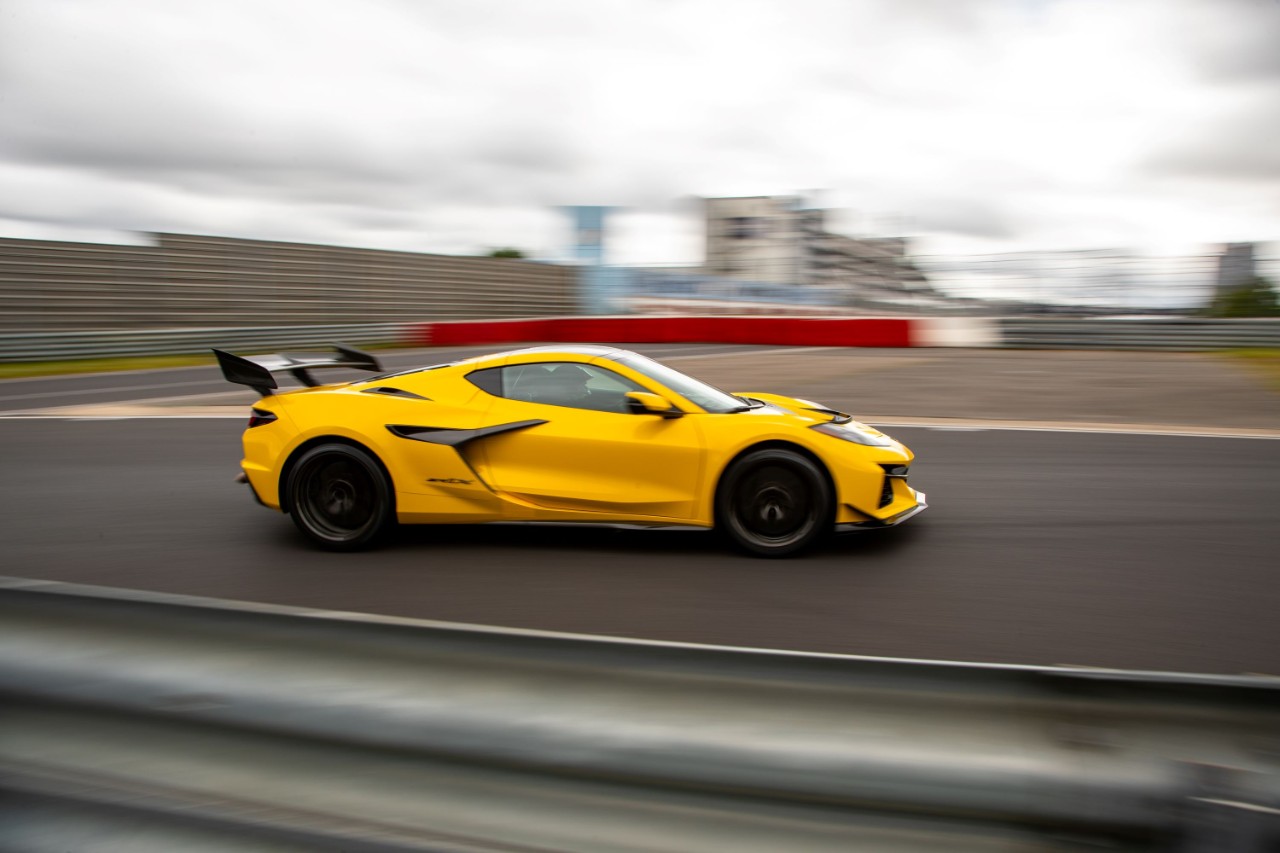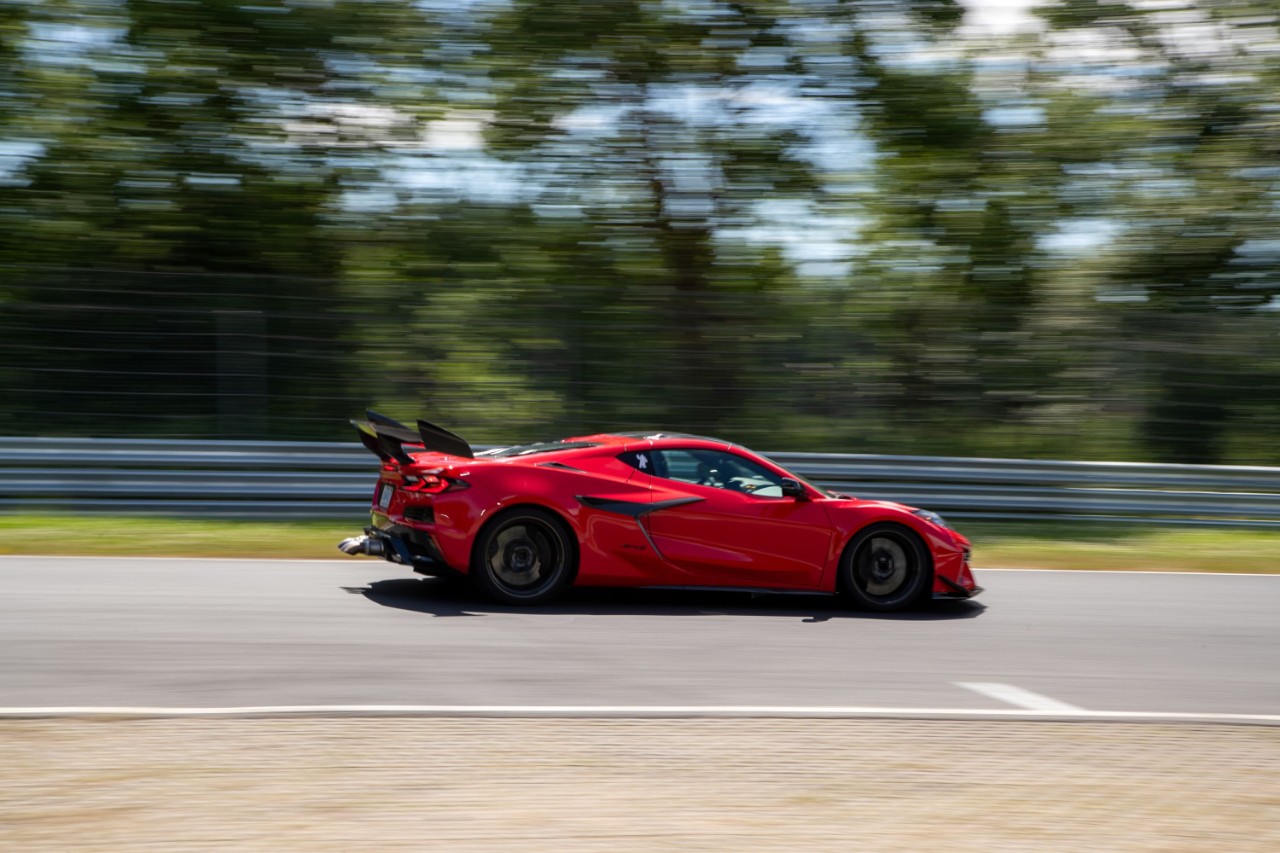By Bob Sorokanich, senior editor, GM News
Germany’s Nürburgring is widely regarded as the most challenging racetrack on earth. In its longest configuration – “Nordschleife,” or “north loop” – a single lap clocks in at 12.9 miles, with 73 corners. The course traverses nearly 1,000 feet of elevation change, climbing and dropping like a high-speed rollercoaster. The entire German village of Nürburg, complete with medieval castle, nestles inside the perimeter of the track. In many places, the track snakes through dense forest, with just a few feet separating the pavement from the trees – hence the Nürburgring’s nickname, “The Green Hell.”
For comparison, Road Atlanta, in Georgia, is considered one of the most technical and demanding old-school racetracks in North America. It measures 2.54 miles, with 12 corners. Last year, the Corvette ZR1 set a production-car record at Road Atlanta, lapping the track in one minute, 22.8 seconds. At the Nürburgring, anything under 8 minutes is monumentally fast; under 7 minutes is rare air.
“It's 12.9 miles of enormous challenge for a vehicle,” Ken Morris said of the Nürburgring. “Within one lap of the ‘Ring, a vehicle is going to experience every type of input that it will anywhere else in the world” – from the low-speed, steeply-banked hairpin turn called the Carousel to flat-out straightaways where world-class supercars can exceed 200 mph. The Nürburgring “challenges everything about the car – the braking, the cooling, the engine performance, the steering,” Morris said. “Over the course of a lap, or multiple laps, does the car stay robust?”
The eighth-generation Chevrolet Corvette just set two of the 10 fastest production-car lap times ever recorded at the Nürburgring. The rear-drive Corvette ZR1 lapped the ‘Ring at 6:50.763; the all-wheel-drive Corvette ZR1X completed its lap in 6:49.275. And the naturally-aspirated Corvette Z06 earned a 7:11.826 lap time. Suffice it to say, the eighth-generation Corvette is more than just robust – it’s a Nürburgring legend.
Morris is senior VP of Product Programs, Product Safety, Integration and Motorsports at General Motors, leading the global team that oversees vehicle development from inception to market debut. He’s also a ‘Ring veteran, having visited the German test track for the first time back in 1997 as a young engineer. “I ran about six laps that time, and since then I’ve run about 2,000 more,” Morris told GM News.
When Corvette engineers began development on the 1,064-horsepower ZR1 and 1,250-horsepower-combined ZR1X, Nürburgring lap times were a top priority.
“When you get to ZR1 and ZR1X levels of capability, we want to document that for everyone to see just how proud we are of our product and our development process,” Morris said. “The statement we're trying to make with Corvette is, this is world-class performance, and the Nürburgring is the most difficult track you can possibly attempt this type of thing on. This is not only a statement for Chevrolet, it's a statement for the engineers and their commitment to excellence and making these cars as good as they can possibly be.”
That commitment extends to driving at the harrowing Nürburgring. And unlike many other automakers, Chevrolet didn’t hire professional racecar drivers to set ‘Ring times. Corvette ZR1X vehicle dynamics engineer Drew Cattell earned the 6:49.275 lap in the electrified all-wheel drive ZR1X, giving him the fastest officially recorded lap time of any non-professional racecar driver at the Nürburgring. ZR1 vehicle dynamics engineer Brian Wallace set the 6:50.763 time in the 1,064 horsepower ZR1, and Corvette vehicle performance manager Aaron Link drove the Z06 to its 7:11.826 lap time.
“We had the development engineers set the times,” Morris said. “Think about how daunting that is – they’re not professional racecar drivers who only drive, they're engineers who happen to be really, really capable drivers as well. They’ve been dialing in everything, like the electronic limited slip differential, the shock tuning, how the steering feels, how the brakes feel, stability control. All those things they know inside and out, so they can maximize the car’s speed at the Nürburgring.”
Knowing the car is just half the battle. “The demands on a driver at the Nürburgring are of the utmost,” Morris said. “It’s a 12.9-mile lap, and every corner, every section is different. To keep your focus up, to maximize your performance at each one of those 73 corners, knowing exactly where to place the car, it’s an enormous challenge mentally as well as physically.”
With Corvette ZR1X currently recognized as the fastest American production car to ever lap the Nürburgring, it’s safe to say that strategy paid off. “I personally am super proud of being able to recognize the kind of talent we have inside the company,” Morris said. “We're not writing checks for people to engineer or drive this car. These are our employees.”

Germany’s Nürburgring is widely regarded as the most challenging racetrack on earth. In its longest configuration – “Nordschleife,” or “north loop” – a single lap clocks in at 12.9 miles, with 73 corners. The course traverses nearly 1,000 feet of elevation change, climbing and dropping like a high-speed rollercoaster. The entire German village of Nürburg, complete with medieval castle, nestles inside the perimeter of the track. In many places, the track snakes through dense forest, with just a few feet separating the pavement from the trees – hence the Nürburgring’s nickname, “The Green Hell.”
For comparison, Road Atlanta, in Georgia, is considered one of the most technical and demanding old-school racetracks in North America. It measures 2.54 miles, with 12 corners. Last year, the Corvette ZR1 set a production-car record at Road Atlanta, lapping the track in one minute, 22.8 seconds. At the Nürburgring, anything under 8 minutes is monumentally fast; under 7 minutes is rare air.
“It's 12.9 miles of enormous challenge for a vehicle,” Ken Morris said of the Nürburgring. “Within one lap of the ‘Ring, a vehicle is going to experience every type of input that it will anywhere else in the world” – from the low-speed, steeply-banked hairpin turn called the Carousel to flat-out straightaways where world-class supercars can exceed 200 mph. The Nürburgring “challenges everything about the car – the braking, the cooling, the engine performance, the steering,” Morris said. “Over the course of a lap, or multiple laps, does the car stay robust?”

The eighth-generation Chevrolet Corvette just set two of the 10 fastest production-car lap times ever recorded at the Nürburgring. The rear-drive Corvette ZR1 lapped the ‘Ring at 6:50.763; the all-wheel-drive Corvette ZR1X completed its lap in 6:49.275. And the naturally-aspirated Corvette Z06 earned a 7:11.826 lap time. Suffice it to say, the eighth-generation Corvette is more than just robust – it’s a Nürburgring legend.
Morris is senior VP of Product Programs, Product Safety, Integration and Motorsports at General Motors, leading the global team that oversees vehicle development from inception to market debut. He’s also a ‘Ring veteran, having visited the German test track for the first time back in 1997 as a young engineer. “I ran about six laps that time, and since then I’ve run about 2,000 more,” Morris told GM News.

When Corvette engineers began development on the 1,064-horsepower ZR1 and 1,250-horsepower-combined ZR1X, Nürburgring lap times were a top priority.
“When you get to ZR1 and ZR1X levels of capability, we want to document that for everyone to see just how proud we are of our product and our development process,” Morris said. “The statement we're trying to make with Corvette is, this is world-class performance, and the Nürburgring is the most difficult track you can possibly attempt this type of thing on. This is not only a statement for Chevrolet, it's a statement for the engineers and their commitment to excellence and making these cars as good as they can possibly be.”
That commitment extends to driving at the harrowing Nürburgring. And unlike many other automakers, Chevrolet didn’t hire professional racecar drivers to set ‘Ring times. Corvette ZR1X vehicle dynamics engineer Drew Cattell earned the 6:49.275 lap in the electrified all-wheel drive ZR1X, giving him the fastest officially recorded lap time of any non-professional racecar driver at the Nürburgring. ZR1 vehicle dynamics engineer Brian Wallace set the 6:50.763 time in the 1,064 horsepower ZR1, and Corvette vehicle performance manager Aaron Link drove the Z06 to its 7:11.826 lap time.

“We had the development engineers set the times,” Morris said. “Think about how daunting that is – they’re not professional racecar drivers who only drive, they're engineers who happen to be really, really capable drivers as well. They’ve been dialing in everything, like the electronic limited slip differential, the shock tuning, how the steering feels, how the brakes feel, stability control. All those things they know inside and out, so they can maximize the car’s speed at the Nürburgring.”
Knowing the car is just half the battle. “The demands on a driver at the Nürburgring are of the utmost,” Morris said. “It’s a 12.9-mile lap, and every corner, every section is different. To keep your focus up, to maximize your performance at each one of those 73 corners, knowing exactly where to place the car, it’s an enormous challenge mentally as well as physically.”
With Corvette ZR1X currently recognized as the fastest American production car to ever lap the Nürburgring, it’s safe to say that strategy paid off. “I personally am super proud of being able to recognize the kind of talent we have inside the company,” Morris said. “We're not writing checks for people to engineer or drive this car. These are our employees.”